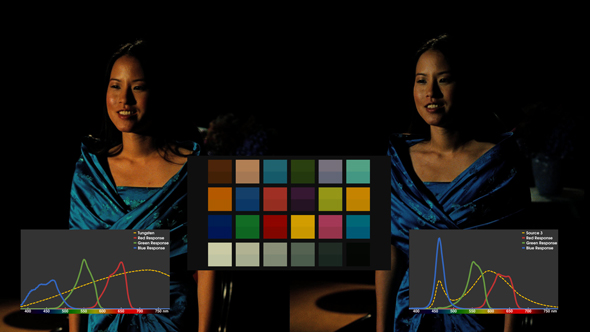
 Colour
Colour
RedShark Replay: If you don't understand how we see colour, you don't understand colour. This may be the most important lesson about colour you ever read (first published October 2014).
There is no such thing as colour, at least in optical physics. Colour is a biological, or even sociological construct. Witness the fact that azure is a shade of blue, but calling azure “blue” in Russian or Italian is as wrong as calling pink “red” in English. But beyond the anthropology of it, anyone who's spent any time behind a camera will be familiar with the problems associated with rendering colours in an acceptable, not to say realistic, manner.
Given that we're taking a spectrum of effectively infinite colour and recording it as a proportion of three red, green and blue primaries, we probably shouldn't be surprised that things sometimes go awry. As the existence of colour rendering indices attest, there's even some concern over creating a reliable and repeatable white light. Even colourlessness is not straightforward.
What's key to all this is the somewhat shaky idea that our eyes, unlike camera equipment, are reliable arbiters of what the world looks like. Even overlooking the somewhat existential concerns about what “red” looks like to different people, it isn't necessarily the case that the human visual system is entirely reliable in matters of colorimetry.
Like cameras, our eyes are at least to some extent tri-stimulus devices, with long (reddish), medium (greenish) and short (bluish) light-sensitive elements. These are fairly unsaturated, with large overlaps, and the green and blue are generally quite close together. Colour vision is therefore quite reliant on what a video engineer would call matrixing, the extraction of extra colour information based on the differences between the three channels as well as their absolute values.
As such, our eyes may be fooled by emitted or reflected light with specific colour properties in much the same way as a camera. While human vision may, through necessity, be our model for ideal camera performance, there's certainly nothing particularly reliable about it as regards the perception of colour.
Simultaneously, the biggest problem and the greatest advantage of this situation is metamerism, the phenomenon by which light with a particular spectrum may appear to some detectors (such as our eyes or a camera) to be identical to light with a different spectrum. Metamerism is a subtle and complicated issue which is both the basis of almost all colour imaging and the source of many of the problems with discontinuous-spectrum light sources such as LEDs and fluorescent tubes.
The problem in detail
Let's look at a simple example. In the figure below, the left-hand chart shows a spectral power distribution – that is, the amount of light at different points on the visible spectrum - for a light source. This light source contains energy at a wide variety of wavelenths, from blue to red with a peak in the blue. The right-hand chart shows a different spectral power distribution including only narrow bands of emission in the red, green and blue, with the blue peak higher.
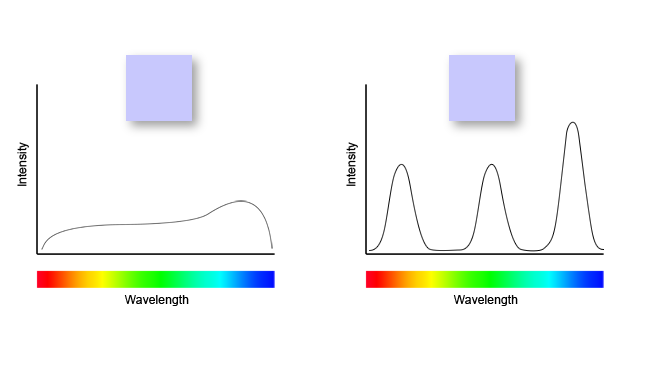
While the mathematics are a little idealised for clarity here, it's quite possible that these two light sources would appear identical – a fairly unsaturated purplish-white. This is, of course, the basis behind which almost all colour imaging operates. A video display cannot actually emit (for instance) orange light, it can only emit red light, and add green to it, such that the result (right) appears to match the orange (left) as photographed:
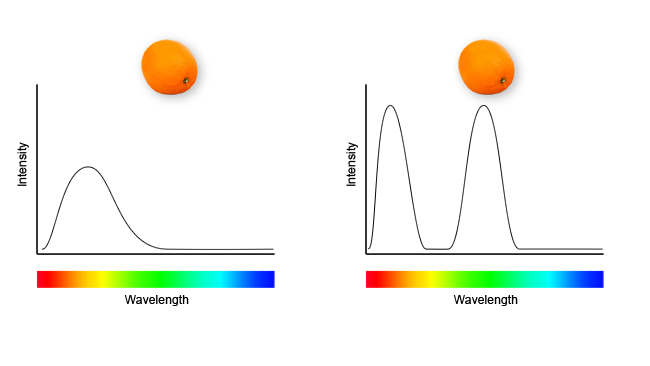
Again, the chart is simplified for clarity, but the problem applies nonetheless. It is for this reason that it is difficult to use RGB colour mixing LED light sources to produce reliable white light. Consider an ideal white light source (white-balanced daylight, for instance) on the left, and the output of the three groups of LEDs on the right:
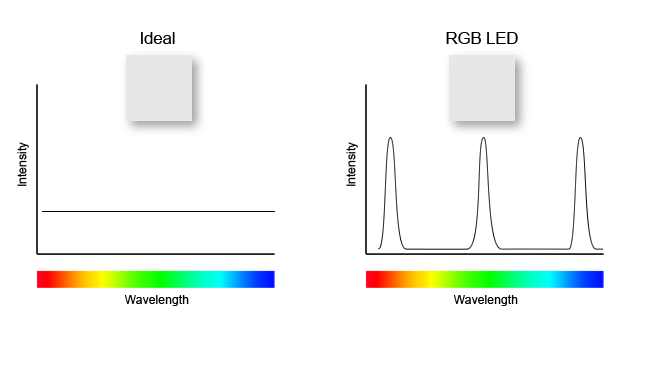
Here, the chart is much less idealised. Red, green and blue LEDs don't quite emit a single wavelength of light, but their emission spectrum really is very narrow, so we end up with three sharp peaks. To the human eye, this might look adequately white when used to illuminate unsaturated objects, although if this sort of light is aimed at something with saturated colour – such as a test chart - most people can quickly tell that something is terribly, if subtly, wrong, even if it's difficult to figure out exactly what and why. If the light reflected by a (for instance) turqoise patch on the test chart happens to line up only with the narrow emission of the blue LED, it might look terribly dim and rather the wrong colour. The output of the RGB LED is shown on both charts in red.
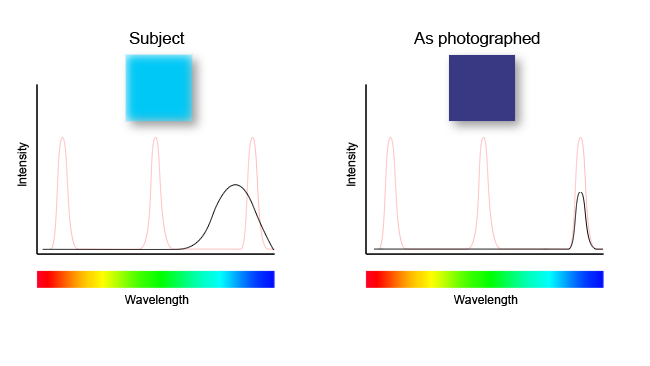
This is an idealised chart based on a real example – even white-emitting LEDs lack blue-green colours, and this problem can occur even with quite good ones.
It is for this reason that we can't inkjet print colour test charts, because printers work by mixing inks, and suffer exactly the same limitations as a display which mixes light. Each square on a colour chart is coloured with a pigment specifically chosen to reflect a particular range of wavelengths, removing metamerism from consideration and permitting light sources to be accurately assessed.
These are somewhat idealised and trivial examples of a very real-world problem. Particularly memorable examples include the picture below first published to illustrate the problems of white-emitting LEDs which depicted a woman in a turquoise silk gown (courtesy AMPAS).
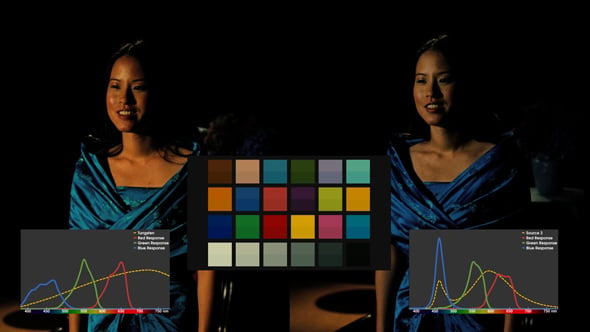
White LEDs, which comprise a blue LED illuminating a yellow-emitting phosphor, are often very deficient in blue-green wavelengths which lie in a valley between the blue of the LED and the yellow of the phosphor. The result is that the silk reflects only the blue light of the LED and simply appears blue, losing the subtleties of its colour.
Metamerism typically operates most convincingly on fairly unsaturated colours, and the most well-known problems with it occur when attempting to evaluate things that are, or at least are supposed to be, white. This is why the CRI evaluation for white light is often questioned – the actual colour patches used in the test are quite unsaturated, which can hide problems.
Unfortunately, colorimeters capable of producing the sort of spectral power distribution graphs used in this article, which are the only way to assess a light source with any real accuracy, are generally expensive and of only occasional use to the cinematographer.
Nonetheless, with more and more discontinuous-spectrum light sources, such as new types of metal halide (metal halide and xenon plasma), LED, ever-developing fluorescents, and of course the need to accurately photograph RGB video displays, the need to be aware of metamerism, as well as the optical physics and biology underlying the problem, has never been stronger.
Tags: Technology


Comments